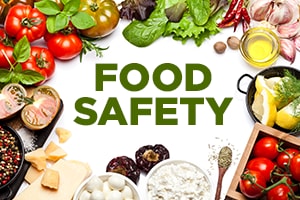Joint Assessments Improve Outbreak Response in Chicago

Chicago may be known as the Windy City, but it also boasts an extensive food scene and is home to over 7,000 restaurants. The city also hosts several large annual food festivals that serve thousands of people over the course of just a few days. Making sure all the food served in the city is safe to eat is a big job, but staff at the Chicago Department of Public Health (CDPH) are up for the challenge.
As an OutbreakNet Enhanced site, CDPH works hard to improve how it detects and investigates enteric disease outbreaks. An example of this is how it uses joint facility assessments to strengthen the relationship between epidemiology and environmental health, and to solve enteric disease outbreaks quicker.
What is a Joint Assessment?
In a joint assessment, environmental health specialists and epidemiologists investigating a foodborne disease outbreak work together to check a facility for contributing factors of contamination. In addition to making outbreak investigations more efficient, joint assessments also give both groups a better understanding of each other’s roles during an outbreak investigation and what information they need to share with each other to move an investigation forward.
The joint assessment teams are one part of a multi-faceted approach that CDPH uses to make the outbreak investigation process more efficient and transparent. Other components include timely analysis of reported exposures, sharing information across epidemiology and environmental health groups, and joint after-action reviews.
Joint Outbreak Investigation Components

What Happens
- Communicable disease control investigators collect key epidemiologic information
- Epidemiologists analyze data quickly
- Epidemiology and environmental health staff share information about an outbreak before the environmental health assessment or re-assessment
How It’s Helpful
These data can guide assessments and sampling, making them more efficient.

What Happens
- Communicable disease control investigators go with environmental health staff to assess facilities
- After the assessment, the team discusses what they found at the facility
- Epidemiologists and environmental health specialists continue working together to determine next steps in the investigation
How It’s Helpful
By inspecting facilities together, communicable disease control investigators and environmental health staff can share important information quickly. This information helps explain what may have caused the outbreak, and lets CDPH take action faster, to prevent more people from getting sick.

What Happens
- After an outbreak investigation ends, all staff who participated in the investigation discuss what went well and what they would do differently during the next investigation
How It’s Helpful
These reviews help to continually improve investigation processes. Action items identified through these reviews also improve guidance and educational resources for food service establishments.
Joint Assessment in Action
In the summer of 2017, CDPH identified a Salmonella outbreak affecting over a dozen people who reported eating at the same barbeque restaurant. When environmental staff assessed the restaurant, CDPH communicable disease control investigators accompanied them. The two groups shared outbreak information before leaving for the assessment. Most patients had eaten the same menu items, which helped the team focus its investigation and environmental sampling.
At the restaurant, environmental health sanitarians inspected the kitchen to look for contributing factors of contamination. Communicable disease control investigators helped interview food workers about their food handling practices. The team shared their findings with each other quickly, and identified several food safety practices that could have contaminated the food customers ate. Working together, the CDPH staff were able to educate the restaurant on what changes it needed to make to stop the outbreak. The restaurant decided to close until food could be prepared safely.
“It was helpful for both the sanitarian and investigator to meet, observe, and learn about each other’s roles as they relate to the foodborne investigation.” – Chicago communicable disease control investigator

Contributing factors are food preparation practices that lead to food getting contaminated with germs, or that lead to germs growing in food. Examples are food workers not washing their hands, and food not being kept at the correct temperature. Environmental health and food safety staff can find contributing factors for outbreaks and help prevent future outbreaks. Click here for more information on contributing factors.